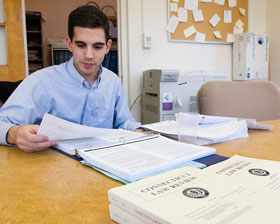  |
| HOME | THIS ISSUE | CALENDAR | GRANTS | BACK ISSUES | < BACK | NEXT > |
Connecticut Law Review helps members develop new skillsby Michael Kirk - February 13, 2006 |
||||
|
The Connecticut Law Review has only about 500 subscribers, but the importance of the journal for students involved in its publication goes far beyond its limited circulation. “Law Review membership allows our members to be involved in the production of a scholarly journal, exposes our members to a diverse range of legal subjects, improves their technical writing skills, and allows them to meet and form friendships with a large number of students at the Law School,” says its current editor, Joseph Bernardi, a third-year law student. Issues have articles written by outside contributors, as well shorter pieces called “notes” and “comments” written by UConn students who are members of the Review. The subjects of the articles and notes in recent issues have ranged from employment discrimination to judicial internationalism. “The quality of the notes and comments are on par with any other article we publish; however due to intense competition among all authors, the opportunity for a student to secure publication in a top legal journal is low,” Bernardi says. Although it is one publication, the Law Review has three formats:
Run by StudentsThe Review was created in 1947, making it the oldest student-run organization at the Law School. Students organized a “Board of Student Editors” to contribute articles on recent court decisions to the Connecticut Bar Journal. This gradually expanded, and the Review became a separate publication in 1968. It began by publishing two issues a year, then four. This year it will publish five times. “I probably spend at least 20 hours a week on Law Review-related work, but that time is often divided among two or three issues because the production schedule for each issue overlaps,” says managing editor Emily Gianquinto, who is responsible for assembly and production. “While I was reviewing proofs of issue one from the printer, I was reviewing edits from issue two and formatting articles for issue three to distribute to the executive editors.” Becoming a memberThe top six day students and top three evening students are invited to join the Law Review. Others may be invited based on their participation in the annual Inter-Journal Summer Write-On Competition, in which students are given a topic to write about. The submissions are scored by the current editorial board of each of UConn’s four law journals. Another way to join is through the Supplemental Writing Competition that takes place each semester. Students submit an original article, which is then reviewed by members of the editorial board; if the consensus is that the article is of publishable quality, an offer will be made to the author to join the Law Review.
Thirty-two new students were invited to join the Review last year. Bernardi joined the publication through the Inter-Journal Summer Write-On Competition after his first year at the Law School. So did Gianquinto. “I wanted to be on the Law Review because my background is in writing and editing,” she says. “I have a journalism degree, and worked for a few years as an editor before coming to law school. I particularly love the production process, so that’s why I ran for managing editor.” National dialogueThe Law Review is funded through subscriptions and support from the Law School. All the senior editorial positions are elected by the members. There are about 60 members, of whom 30 are on the editorial board. The Review’s faculty advisor, Professor Paul Schiff Berman, supervises the journal and consults with the student editors on decisions and policies. “The mission of the journal is to contribute to the national dialogue among scholars, judges, and practitioners of the law on the important legal issues of the day,” says Berman. “It also provides students with significant editorial experience and writing opportunities.” Berman became faculty advisor when he arrived at the Law School six years ago and was asked by the then-editor to take on the role. “I recognized that the Review was an important way in which the school as a whole contributes to the outside world,” he says. “It is also a great opportunity for me to engage serious students in substantive discussions concerning their significant research projects.” Bernardi says he is most proud of the student contributions to the publication. “Giving our members the opportunity to publish in Connecticut Law Review is a tremendous opportunity for them that would otherwise likely be unavailable,” he says. “I personally get great satisfaction from helping to share our forum with our members.” In April, the Law Review will host the annual Day, Berry, and Howard lecture series. This year’s guest is Supreme Court Justice Antonin Scalia, who will speak at the Law School over two days. |
| ADVANCE HOME UCONN HOME |

